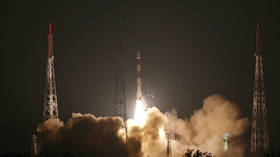India 'revives' rocket's upper stage for space experiments in world first

India is the first country to use the burnt-out upper stage of a rocket as a platform for space experiments after delivering a tiny, student-built satellite into orbit.
An updated version of India's Polar Satellite Launch Vehicle (PSLV-C44) was used on Thursday to deliver two communications satellites into orbit. After unloading a 740kg Microsat-R military satellite into position roughly 274km above the surface of the Earth, the fourth stage (PS4) of the rocket then proceeded to a higher circular orbit (453km) to deliver the second payload and "establish an orbital platform for carrying out experiments."
The 10cm Kalamsat-V2, developed by students from the Space Kidz India foundation, is set the "first to use PS4 as an orbital platform," the Indian Space Research Organisation (ISRO) said.
"India... becomes the first country to use the fourth stage of a space rocket as an orbital platform for micro-gravity experiments," Prime Minister Narendra Modi tweeted, congratulating the space team on their success.
With this launch, India also becomes the first country to use the fourth stage of a space rocket as an orbital platform for micro-gravity experiments. @isro
— Narendra Modi (@narendramodi) January 25, 2019
Rockets have been expendable ever since the Soviet Union sent Sputnik, the first artificial Earth satellite, into orbit in 1957. The various segments break away during ascent, eventually ending up as space debris. To reduce the clutter in space, Indian scientists simply tried to prolong the use of the last stage of the PSLV by converting it into a platform.
"By inserting batteries and solar panel, we can increase its lifespan in space for months by making it communicable (controllable) from the ground station," Kailasavadivoo Sivan, ISRO's chairperson, explained.
"It can then be used as a platform for performing experiments like the study of upper atmosphere parameters, microgravity tests and observation of space."
🇮🇳 #ISROMissions 🇮🇳Take a look the mission at a glance.#PSLVC44#MicrosatR#KalamsatV2pic.twitter.com/GTlKYY3dhZ
— ISRO (@isro) January 24, 2019
Like this story? Share it with a friend!













